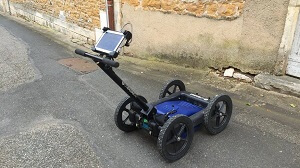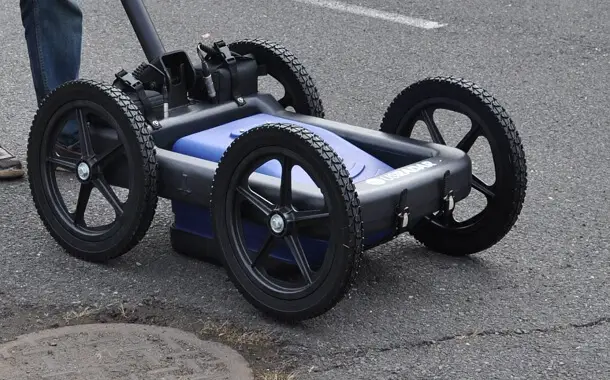Ground Penetrating Radar Cost
Last Updated on September 13, 2023
Written by CPA Alec Pow | Content Reviewed by ![]() CFA Alexander Popinker
CFA Alexander Popinker
Impulse radar or GPR (Ground Penetrating Radar), is a piece of equipment with a technology that allows the investigation of the soil structure and the location of underground facilities. In archeology, it is useful for identifying hidden structures.
How Much Does Ground Penetrating Radar Cost?
In general, the cost of a GPR (Ground Penetrating Radar) would start at around $16,000 and goes up to $95,000 for a brand-new device. A GPR that requires an experienced user will cost more than $36,000, while for a simple system, you will have to pay less than $12,000.
For example, according to a member of the online forum thread TreasureNet.com, the cost of a GPR on eBay is around $4,000. On the same forum, another member said that a brand-new device costs a minimum of $32,000.
We found a slightly used GPR equipment on eBay that costs $8,000 to $13,000.
You can purchase a unique GPR and the necessary software for around $16,000 from the AccurateLocators website. Though, you will have to buy the antenna system separately. This would cost anywhere between $3,000 and $7,000, depending on the frequency.
Depending on the certain model, the price of GPR starts at around $14,500, according to the official website of US Radar, Inc. This price includes the software for doing the basic utility locating, the battery, tablet and cart.
What is its operating principle?
G.P.R. emits an electromagnetic signal by means of a radio wave. GPR allows investigating the structure of the pedological substratum and underground facilities, without interfering with them.
Thanks to the method, prospecting becomes more efficient from an economic and time point of view, bringing an obvious advantage over the classic technology based on installments. This method is based on the property of waves to reflect from different obstacles, depending on their electromagnetic characteristics.
You might also like our article about the cost of a metal detector.
The system is composed of a data recording unit and two antennas, one low frequency and one high frequency, representing a transmitter and a receiver. The transmitter emits electromagnetic pulses that are reflected and detected by the receiver according to the characteristics of the explored environment.
The maximum penetration depth of the propagating wave depends on the wavelength of the radiation used and the dielectric constant of the investigated medium.
Which are the additional expenses?
Besides the GPR you will need a laptop and software in order to use a ground penetrating radar. In case the device does not come with the software, you will have to pay another hundred dollars for it. The software will gather the information from the GPR and set it to a map. Also, this software will help mark a certain area and locate utilities. It is very important to use a laptop as well because you will have to be able to interpret the GPR results directly at the job site and on the go.
Plan on spending around $650 or more for accessories such as a survey wheel which can control de readings or extra antennas.
Usually, an advanced GPR will require an experienced user, and if you don’t know how to operate the device, you will have to take a course to learn how to use it.
Important things to consider
 The difference between the GPR models consists in the type of frequencies used and the number of antennas used, the way of working with the software, the way of calibrating the antennas and calibrating the soil as well as the way of merging the scans (only valid for some models) and whether they have a 3D mode or not (array – multiple longitudinal and transverse scans or orthogonal grid).
The difference between the GPR models consists in the type of frequencies used and the number of antennas used, the way of working with the software, the way of calibrating the antennas and calibrating the soil as well as the way of merging the scans (only valid for some models) and whether they have a 3D mode or not (array – multiple longitudinal and transverse scans or orthogonal grid).
In choosing the GPR model, the name of the manufacturing company is not important. What the device is capable of doing is more important, as well as what you, as a buying company, want from a GPR. Thus, it is recommended to look at what frequencies the GPR works on and how many antennas it has. It should have at least 2 antennas. Operating frequencies should be between 200 and 1000 Mhz.
When we talk about the technical conditions – soil, weather, humidity, etc. – which you must have for a good result, the general condition for all GPRs is the lowest possible soil conductivity. This low conductivity medium is an excellent condition for GPR determinations (<10-7 S/m). Such values are specific to air, granitic rocks or sandstones lacking moisture, concrete, asphalt. On the other hand, it is difficult to do a scan in rain or snow even if the device has IP65. Instead, to determine damage, dry weather is needed for a period of time to immediately notice infiltration.
Important to note is that this is not a geophysical method that can be immediately applied to all geographic or archaeological domains, although with careful and thorough modifications in data acquisition and processing methodology, GPR can be adapted for a wide variety of site conditions.
Tips for saving money
It is not common to find a GPR on Craigslist or eBay, but you should keep searching on these websites because in the event that you find one, you may be able to save hundreds, if not thousands of dollars on a second-hand model.
Depending on the job size, services would cost anywhere between $320 and $2,700 per day.


Leave a Reply
Want to join the discussion?Feel free to contribute!